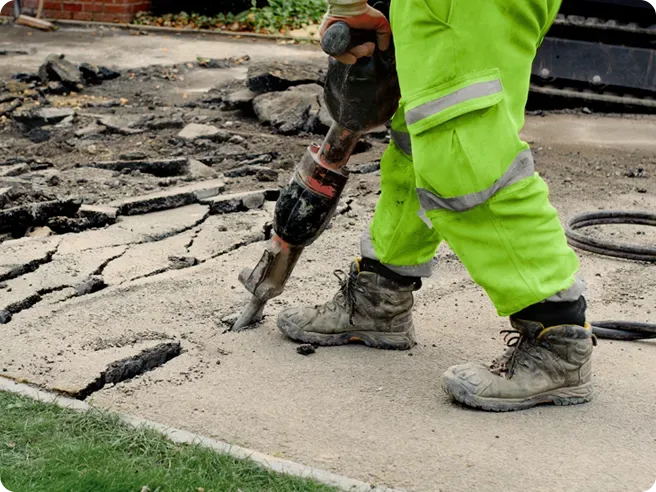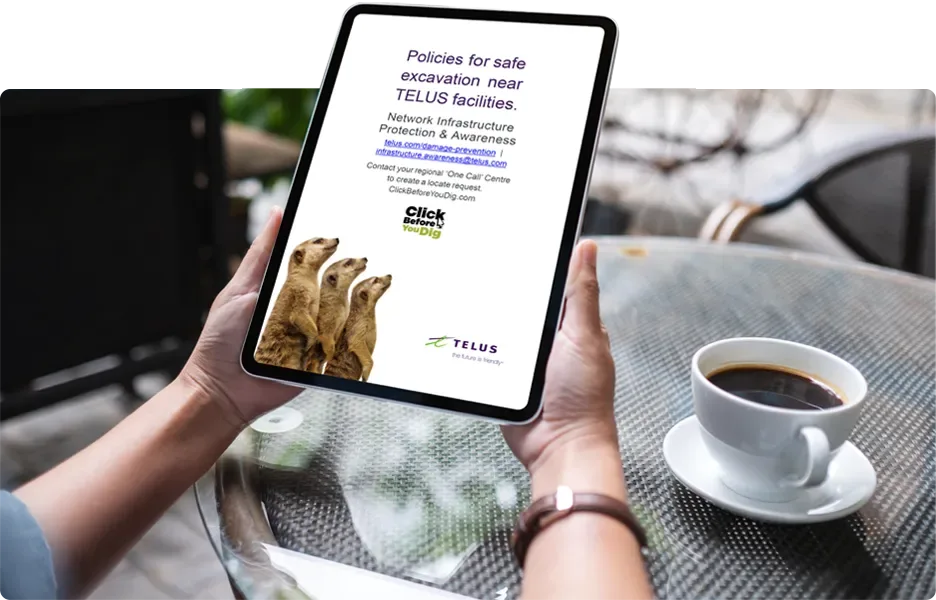Network Infrastructure Protection and Awareness
Helping you dig safely to protect TELUS underground infrastructure.

Our customers
We provide guidance for people planning projects that involve digging and excavation in order to protect TELUS underground infrastructure. This guidance applies to everyone who plans to dig, from a homeowner adding a garden to a new building construction site.

Homeowners
Activities like fencing, gardening and landscaping may lead to damage to underground utilities that you can't see. To avoid damage and stay safe, you must submit a Locate request before you start digging.

Commercial projects
Commercial and government excavation projects require a lot of planning to protect underground utilities. The planning process will likely involve many Locates on the construction site before any digging is started.

Locate professionals
Locate professionals travel to a work site to mark where underground utilities are in order to prevent damage. In British Columbia you must hire a Private Locator for your excavation project.
Everyone has the responsibility to dig safely. Learn more about
Ground Disturber Responsibilities.
Safe digging policies

Learn more about how to prevent damage to underground utilities during digging or excavation projects. These policies contain valuable information for anyone planning to disturb the ground anywhere in Canada.
This document was last updated on March 28, 2024.
Get ready to dig
Anyone planning to disturb the ground for any size project is required to request a Locate with their provincial One Call Centre. It's free, it's easy and it's the law. Following this process protects you, underground utilities, and your community.
A Locate is when a professional Locator is sent to a requested location in order to mark and identify the buried utilities with paint or flags. These markings indicate where underground utilities are so you can avoid them. Learn more about what happens in your province during the Locate process by reviewing the steps below.
- Step 1Gather InformationYou will need to gather details about your project that you can pass onto your provincial One Call Centre. This includes: the location of the excavation, the type of work being done, your method of excavation, the depth of your excavation, the planned start date of the work, who the work is being done for, whether you are working on private or public property and your contact information.
- Step 2Contact your One Call CentreVisitwww.clickbeforeyoudig.comand select your province to get the contact information for your One Call Centre. Contact the One Call Centre (online or by phone) to provide information about your project.
Wait for confirmation and follow the required wait times for utility companies to mark underground infrastructure before excavation.When you submit a Locate request, the One Call Centre will automatically notify any utility owners with underground utilities in the area based on the project information you provided. - Step 3Utility owner reviewUtility owners, including TELUS, will review the Locate request for potential risks to underground facilities. You are responsible for hiring a Private Locator if there is a conflict. A clearance will be issued if there are no conflicts.
- Step 4Locate completedIn British Columbia, you must coordinate with your Private Locator to ensure Locates are completed and proper documentation is received.
- Step 5Digging beginsOnce the field Locate is complete and you receive all necessary documentation, you may start your excavation project as planned. Locates and markings are valid for a specific period of time. If your project goes beyond the Locate dates, you must submit a new Locate request to the One Call Centre.Proceed with caution: use caution while you work to prevent damage to underground utilities.
Damages
If damage to a utility occurs: stop work immediately, evacuate the area and contact emergency services if necessary.
Then notify your provincial One Call Centre at
Then notify your provincial One Call Centre at
bc1c.ca
. The impacted utility owner(s) will review the Damage Notification and follow up with you.Emergency Locates
For urgent situations where immediate action is needed to repair a condition that poses a threat to life, health, or property you may submit an emergency Locate request through your One Call Centre. This includes the repair of essential services like water, power, phone or gas.
Frequently asked questions
You are currently viewing the questions and answers for British Columbia. If you'd like to see information for another Province or Territory, please use the region selector in the top right of the page.
Contact us
Our team members are ready to help you with questions about your Locate request or any TELUS utility concerns. Please reach out to our team by email:
